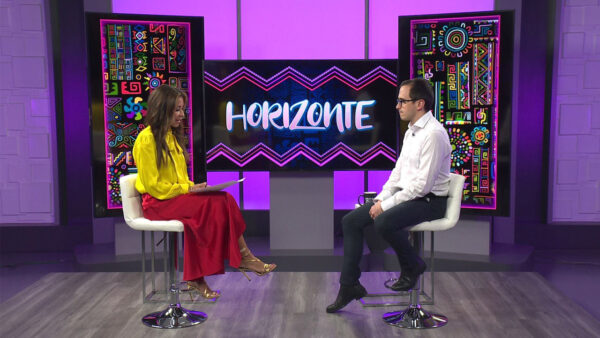Arizona Opera brings the world’s first mariachi opera to the stage. Cruzar la Cara de la Luna blends the artistry and passion of mariachi with the story of a Mexican immigrant family. Arizona Opera General Director Ryan Taylor and James Garcia, community liaison for the Arizona Opera discuss the upcoming performances.
José Cárdenas: Joining me to talk about "Cruzar La Cara De La Luna" are James Garcia, Arizona opera community liaison, and Ryan Taylor, Arizona opera general director. Gentlemen, thank you for joining us on "Horizonte." The words opera and mariachi, I don't think I've ever seen together in a sentence before. How did this happen?
Ryan Taylor: It is a pretty fantastic mash-up of the two art forms. Houston grand opera commissioned the piece in 2010, which was the premier. And they have a section of their company called HGO-CO dedicated to finding the next great American opera stories. They go out into the communities throughout Houston and sort of encouraging people to tell their own personal stories. This is actually based on a real story of a gentleman whose family they met. And they put mariachi Vargas together with the stage director who wrote the book and created a piece, work-shopped it over several years time and created something magical.
José Cárdenas: James, we say mariachi, this is not just -- this is mariachi Vargas, most famous mariachi in the world.
James Garcia: Roots traced back to the 19th century in Mexico, mix of Spanish music, native Mexican music, and mariachi Vargas as an organization, stretches back to 1898, and they were somewhat regional band until like the mid-30s when they were sort of discovered, if you will, and they are the premier mariachi group perhaps in Mexican history, and they part of this opera. Quite astounding.
José Cárdenas: How did they get involved?
Ryan Taylor: From what I understand, opera recognized it was a story that needed to be told in a different way, classical orchestra and opera singing by itself. Reached out for Vargas. It hadn't occurred to them yet. The styles of vocalism are not dissimilar between mariachi and opera. I think for them it felt like an exciting project and they were happy to jump on board.
José Cárdenas: We have the stereotypes of opera as kinds of an old fogey, you know, quote, unquote, fat lady singing up on the stage in Italian or some other foreign language and you have to have subtitles to understand it. How are you convincing people to go to this?
Ryan Taylor: I think first you're talking about stereo types of traditional opera performing. But in order for you to understand how far those are off, you have to at least come and visit us once. I would dare you to sort of find the stereo typical what you think of as an opera singer on our stage. Nowadays, they're incredibly live, vibrant young performers that look in many cases like they belong in Hollywood. And it doesn't mean that we don't have artists of all shapes and sizes, but the stereotypical image of when you go you will see this, is not accurate any longer. With this particular piece, I think just the curiosity factor of being able to see how you would combine the two art forms, as you said at the beginning of the interview, the words mariachi and opera together, how does that work -- is sort of driving a lot of interest in the piece.
José Cárdenas: James, you interviewed one of the main performers in this opera. Didn't you have that kind of same sense of how do you make this work?
James Garcia: Well, not so much, only because I had long thought of the idea of mariachi being operatic, a certain quality -- as a playwright, a play that is not an opera, but a -- a one act that deals with mariachi music, traditional mariachi music. I had that connection. When I heard sing it, I was moved to tears. Taking the genre of opera, and the quality of the vocalism, and melding it to mariachi in a way I have never heard before. When people come, they will be surprised across the board but surprised in a good way to hear what they are going to hear.
José Cárdenas: Let's talk a little more about the story. Opera is about stories. As we're talking, we are going to have some pictures on the screen. Illustrating some of the scenes. Tell us about the stories. I understand it spans several generations of a particular person's life.
Ryan Taylor: It does. It sort of tells the story of a family separated by the border. The story of an immigrant who has come to the United States, marries into an American family, and as he is in his advance stage of life, brings both sides of his family together and tells stories and recollections about his experience and what -- what that has been like growing up sort of being split between two nations, and the most fascinating part of this piece for me is to read the reactions that it has received from Paris and --
José Cárdenas: For example, the scene we have up on the screen, it shows the crossing of the border --
Ryan Taylor: Yeah, that's the moonlight of the journey between the two countries, and pretty powerful stuff.
José Cárdenas: Explain the title.
Ryan Taylor: I actually can't speak to the title so much as the idea that the moon is the same no matter where you are in the world. And I think to find a piece that speaks to a journey, both physical and mental and through time stems against the face of the moon in a sort of really interesting way.
José Cárdenas: You mentioned Paris.
Ryan Taylor: Uh-hmm.
José Cárdenas: This has been performed in Paris, France.
Ryan Taylor: It has. We will be the 5th company to produce the piece. It has been in Chicago, San Diego, Houston, and Paris. And to find people, even among my staff from -- whose families are from Japan or from England who have said, you know, this is not my family's story, but the similarities in what we deal with as an immigrant family are so common that we understand the piece in a pretty deep way.
José Cárdenas: Any political significance?
Well, particularly in Arizona, which has been described in the past as ground zero --
James Garcia: I will speak to that. I don't actually work for the opera. I have an affiliation with them because -- a playwright, but the reason I'm attached to this and talking this opera up so much is because it is a story that is perfect for this time. I mean, we've gone through some ugliness. We are in a period in which we need to let the community know here, not just the immigrant community, Latino community, broader community, and need to let the country know that this is a time to bridge communities. And that's what this metaphorically really this story is about, about bridging communities across the border. I'm really moved by the fact that the Arizona opera is not just presenting this piece, but opening its season with it and sending a message that not only should we value the contributions of immigrants in Arizona, but that it should be part of the full breath of what art is in the state of Arizona. And it moves me on a lot of levels because It is sending a very clear message that we don't want to be seen as a state that somehow isn't tolerant of this community.
José Cárdenas: And Ryan, as James said, Arizona opera is not simply presenting this piece, you are doing other things as well, educational components.
Ryan Taylor: We are. We begin Monday night of next week with a week-long festival of heritage events. A panel discussion one evening on the role of the arts in cure -- Curating this continual dialogue. A former professor coming in to talk about the tradition of mariachi and how are the costumes made and why are the instruments different than what you might see in a classical orchestra. A cultural exchange one evening, all kinds of folks who developed arts and crafts out of their cultural backgrounds. Those will be for sale in an environment where we will be presenting local mariachi and ballet folklorical groups. A student -- bringing about 1,400 kids in to see the show that wouldn't otherwise have an opportunity to do so. All of that combined with the fact that we are the first company to present it not only to open a season with it, but to include it in our subscription season. So, if you're subscribing to the opera this year, you are going to be in the same place as any single ticket buyer taking advantage of this unique opportunity all at once. We're blending old and new audiences at the same time.
José Cárdenas: And James, what is the role of the arts? These traditional arts in addressing these kinds of issues. You are a note the playwright. You just -- noted playwright. You just finished one of your plays, particularly political satire. How does this work?
James Garcia: It's Cliché, but art is always a mirror. Always a mirror. Created because as artists you're absorbing what is happening around you. I think that this piece, one of the reasons that I think it is going to be so powerful for people in this audience is in part because we've gone through some experiences that are directly interpreted through the story line of this play. And that can be political. It can be cultural. But it's going to be a powerful story to the audience because it's reflecting what has been happening in our country in this part of the country.
José Cárdenas: Ryan, we're almost out of time. This is not the only thing that Arizona opera is doing to expand the traditional audience. Tell us quickly what else --
Ryan Taylor: We were able to launch about two weeks ago now a brand new four-year community-based artistic initiative to present a couple of works each year specifically geared to new and different audiences than we typically serve at the opera. So, we have pieces specifically for the Hispanic community, which will come in two years' time, we are looking at -- that piece written by Daniel Caton, recently passed -- and also looking at a premier --
José Cárdenas: There is a lot to look forward to
Ryan Taylor: Absolutely.
José Cárdenas: This sounds like an exciting start. Thank you both.
Thank you. And that's our show for tonight. From all of us here at "Horizonte" and eight, thank you for watching. I'm Jose Cardenas. Have a good evening. MM
Funding for "Horizonte" is made possible by contributions by the friends of eight, members of your Arizona PBS station. Captioning Performed by LNS Captioning www.lnscaptioning.com
Ryan Taylor:General Director, Arizona Opera; James Garcia:Community Liaison, Arizona Opera;




















